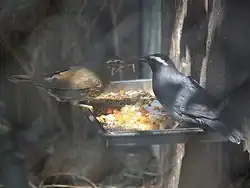Geokichla
| Geokichla | |
|---|---|

| |
| Siberian thrush (Geokichla sibirica) | |
| Scientific classification | |
| Kingdom: | Animalia |
| Phylum: | Chordata |
| Class: | Aves |
| Order: | Passeriformes |
| Family: | Turdidae |
| Genus: | S. Müller, 1836 |
| Type species | |
| Turdus citrinus[1] Latham, 1790
| |
Geokichla, from Ancient Greek γεω- (geō-), meaning "ground", and κιχλη (kikhlē), meaning "thrush"[2], are a genus of medium-sized thrushes who are mostly insectivorous or omnivorous in the thrush family, Turdidae. They were traditionally listed in the Zoothera, but molecular phylogenetic studies published in 2008 led to their placement in a separate genus.
Taxonomy
The genus Geokichla was introduced in 1836 by the German naturalist Salomon Müller with Turdus citrinus Latham, 1790, the orange-headed thrush, as the type species.[3][4][5] The genus name comes from Ancient Greek γεω- (geō-), meaning "ground", and κιχλη (kikhlē), meaning "thrush.[6]
These species were formerly placed in the genus Zoothera. Molecular phylogenetic analysis by Gary Voelker and collaborators published in 2008 found that Zoothera was polyphyletic.[7][8] To create monophyletic genera 21 species were moved from Zoothera to the resurrected genus Geokichla.[9]
List of species
The genus contains the following 21 species:[9]
- Siberian thrush, Geokichla sibirica
- Pied thrush, Geokichla wardii
- Grey ground thrush, Geokichla princei
- Black-eared ground thrush, Geokichla camaronensis
- Spotted ground thrush, Geokichla guttata - formerly G. fischeri
- Spot-winged thrush, Geokichla spiloptera
- Crossley's ground thrush, Geokichla crossleyi
- Abyssinian ground thrush, Geokichla piaggiae
- Kivu ground thrush, Geokichla piaggiae tanganjicae
- Oberländer's ground thrush, Geokichla oberlaenderi
- Orange ground thrush, Geokichla gurneyi
- Orange-headed thrush, Geokichla citrina
- Buru thrush, Geokichla dumasi
- Seram thrush, Geokichla joiceyi
- Orange-sided thrush, Geokichla peronii
- Slaty-backed thrush, Geokichla schistacea
- Chestnut-capped thrush, Geokichla interpres
- Enggano thrush, Geokichla leucolaema
- Chestnut-backed thrush, Geokichla dohertyi
- Ashy thrush, Geokichla cinerea
- Red-backed thrush, Geokichla erythronota
- Red-and-black thrush, Geokichla mendeni
A subfossil specimen of a ground thrush has been found on the island of Mauritius:[10]
- Mauritius ground thrush, Geokichla longitarsus
References
- ^ "Turdidae". aviansystematics.org. The Trust for Avian Systematics. Retrieved 2023-07-15.
- ^ Jobling, James A. (2010). The Helm Dictionary of Scientific Bird Names. London: Christopher Helm. p. 172. ISBN 978-1-4081-2501-4.
- ^ Müller, Salomon (1836). "Aanteekeningen, over de natuurlijke gesteldheid van een gedeelte der westkust en binnenlanden van Sumatra, met bijvoeging van eenige waarnemingen en beschrijvingen van verscheidene op dit, en andere Sunda-eilanden voorkomende dieren". Tijdschrift voor Natuurlijke Geschiedenis en Physiologie (in Dutch). 2: 315–355 [348–349].>
- ^ Mayr, Ernst; Paynter, Raymond A. Jr, eds. (1964). Check-List of Birds of the World. Vol. 10. Cambridge, Massachusetts: Museum of Comparative Zoology. p. 144.
- ^ Dickinson, E.C.; Christidis, L., eds. (2014). The Howard & Moore Complete Checklist of the Birds of the World. Vol. 2: Passerines (4th ed.). Eastbourne, UK: Aves Press. p. 619. ISBN 978-0-9568611-2-2.
- ^ Jobling, James A. (2010). The Helm Dictionary of Scientific Bird Names. London: Christopher Helm. p. 172. ISBN 978-1-4081-2501-4.
- ^ Voelker, G.; Klicka, J. (2008). "Systematics of Zoothera thrushes and a synthesis of true thrush molecular relationships". Molecular Phylogenetics and Evolution. 49 (1): 377–381. doi:10.1016/j.ympev.2008.06.014. PMID 18639642.
- ^ Voelker, G.; Outlaw, R.K. (2008). "Establishing a perimeter position: speciation around the Indian Ocean Basin". Journal of Evolutionary Biology. 21 (6): 1779–1788. doi:10.1111/j.1420-9101.2008.01588.x. PMID 18691238.
- ^ a b Gill, Frank; Donsker, David; Rasmussen, Pamela, eds. (July 2023). "Thrushes". IOC World Bird List Version 13.2. International Ornithologists' Union. Retrieved 13 December 2023.
- ^ Hume, J.P. (2022). "A new subfossil ground thrush (Turdidae: Geokichla) from Mauritius, Mascarene Islands". Bulletin of the British Ornithologists' Club. 142 (4): 388–403. doi:10.25226/bboc.v142i4.2022.a2. S2CID 254367025.
External links
- Asian thrush videos on the Internet Bird Collection